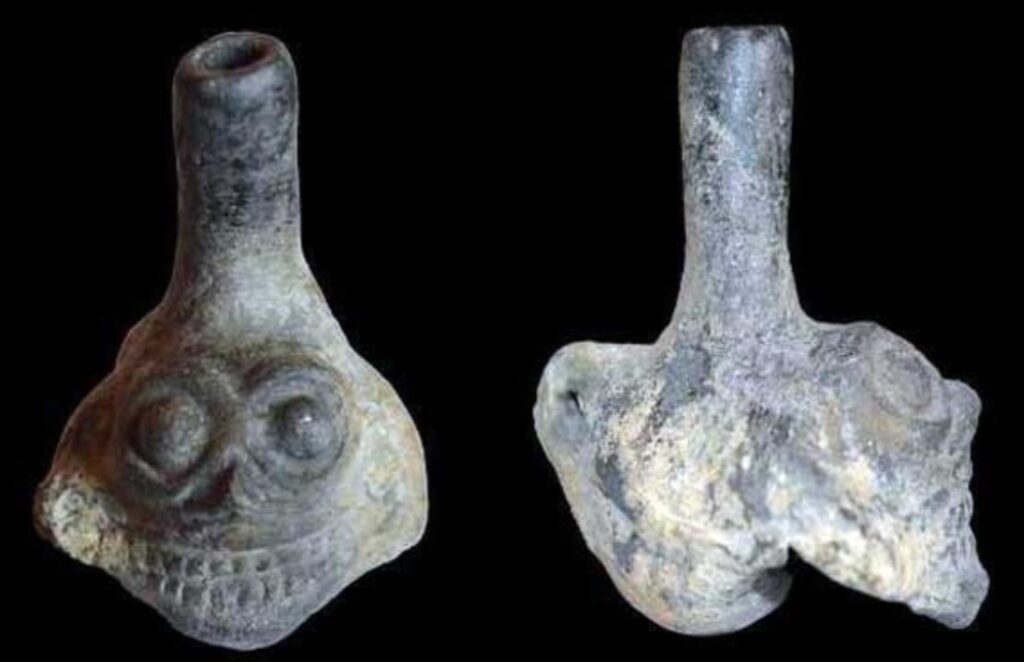
Scientists discover that Aztec ‘Death Whistles’ have strange effects on listeners’ brains
New research has uncovered that one of the most eerie artifacts of the Aztecs, clay death whistles shaped like human skulls and capable of producing a scream-like sound, not only terrified listeners in ancient times but also significantly impacted the human brain’s capacity to heighten feelings of alarm and fear.
The recent study, published this month in the journal Communications Psychology, examined the effects of these sounds on contemporary listeners, revealing their ability to provoke negative emotional reactions and heightened neural activity in the auditory cortex.
For the first time, scientists explored the influence of these unsettling whistles on the brains of modern European participants, conducting two distinct experiments with different groups of volunteers.
Typically resembling skulls, Aztec death whistles were crafted to emit a high-pitched, penetrating sound akin to a scream, resulting from the interaction of various air currents. Numerous examples have been discovered in graves dating from 1250 to 1521 CE.
It is believed that the ancient Aztecs utilized death whistles to instill fear in their enemies during combat. They are often found alongside the remains of sacrificial victims, leading to theories that they may have served a more ceremonial purpose. Some experts suggest that the whistles were designed to mimic the piercing winds of Mictlan, the Aztec underworld believed to receive sacrificial offerings. Others think the sound was meant to represent Ehecatl, the Aztec God of the Wind, who is said to have created humanity from the remains of the deceased.

Researchers enlisted modern European volunteers to conduct a series of psychoacoustic tests. When the participants’ neural and psychological responses to the death scream were recorded, it was found that the sound was perceived as having a “hybrid natural-artificial origin,” complicating the brain’s ability to categorize it.
Participants described the sounds as “frightening” and “aversive,” aligning with the intended use of the whistles in Aztec rituals and warfare.
The psychoacoustic experiments conducted in this study revealed that the brain interprets the sound as both natural and artificial, creating a sense of ambiguity that captures mental focus. This intricate reaction involves both lower-order auditory processing and higher-order cognitive functions, intensifying the emotional effect of the sound.
In other words, the terrifying ambiguity of the death whistle seems to ignite the imagination as the brain attempts to interpret the sound’s symbolic significance. Consequently, the researchers conclude that the whistles were likely used in ritual contexts, particularly in sacrificial rites and ceremonies associated with the deceased.
These sounds may have been designed to instill fear in sacrificial victims or evoke admiration in those present at the ceremonies.
Thus, the researchers propose that these whistles were intentionally employed during Aztec rituals to elicit strong psychological responses.
Frühholz, S., Rodriguez, P., Bonard, M. et al. Psychoacoustic and Archeoacoustic nature of ancient Aztec skull whistles. Commun Psychol 2, 108 (2024).
doi.org/10.1038/s44271-024-00157-7
Cover Image Credit: Wikipedia Commons
You may also like
- A 1700-year-old statue of Pan unearthed during the excavations at Polyeuktos in İstanbul
- The granary was found in the ancient city of Sebaste, founded by the first Roman emperor Augustus
- Donalar Kale Kapı Rock Tomb or Donalar Rock Tomb
- Theater emerges as works continue in ancient city of Perinthos
- Urartian King Argishti’s bronze shield revealed the name of an unknown country
- The religious center of Lycia, the ancient city of Letoon
- Who were the Luwians?
- A new study brings a fresh perspective on the Anatolian origin of the Indo-European languages
- Perhaps the oldest thermal treatment center in the world, which has been in continuous use for 2000 years -Basilica Therma Roman Bath or King’s Daughter-
- The largest synagogue of the ancient world, located in the ancient city of Sardis, is being restored











Leave a Reply